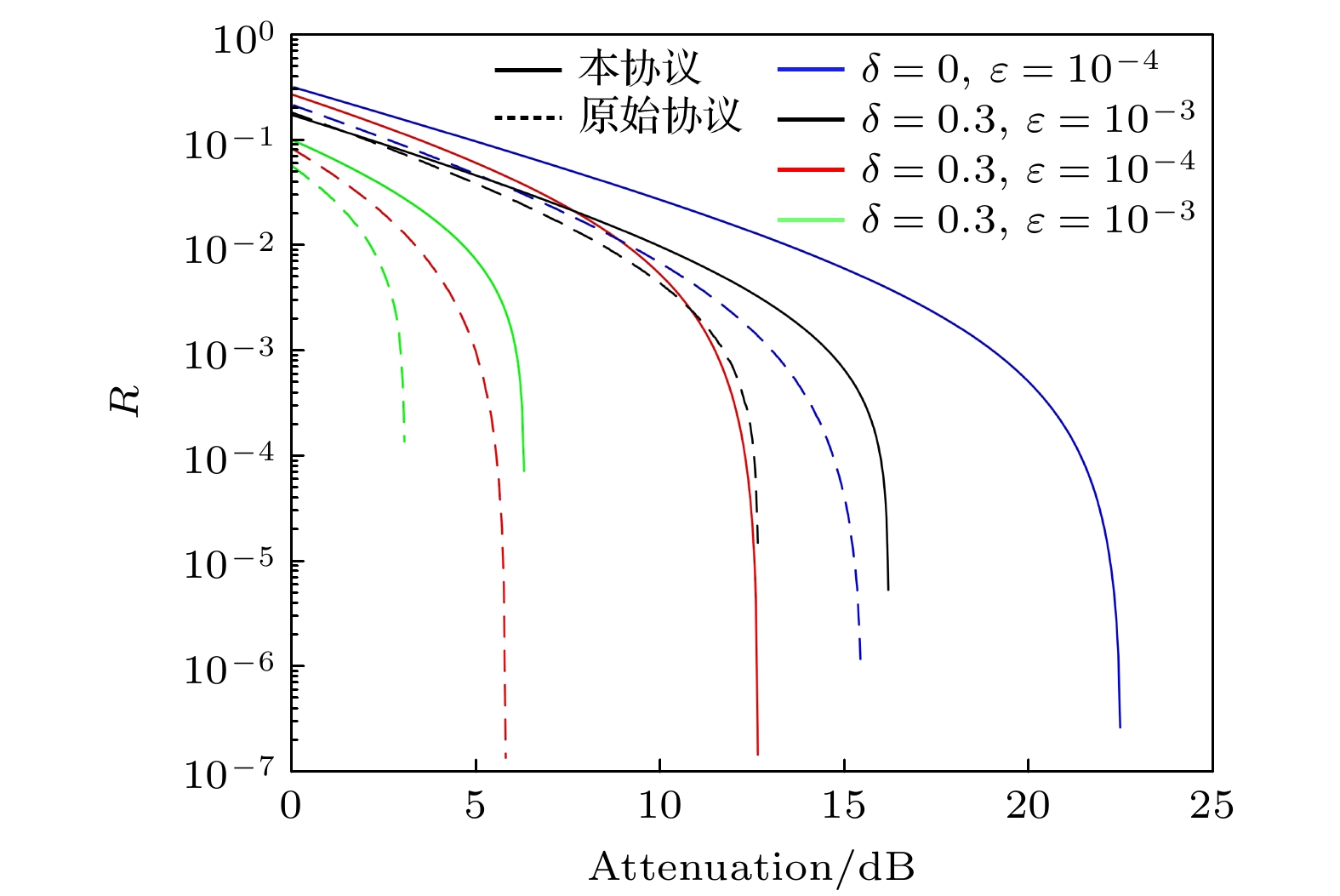-
Based on the basic principles of quantum mechanics, quantum key distribution (QKD) provides unconditional security for long-distance communication. However, existing QKD with relevant source protocols have limited tolerance for source correlation, which greatly reduces the key generation rate and limits the secure transmission distance, thereby limiting their practical deployment. In this work, we propose an improved QKD with correlated source protocol to overcome these limitations by discarding the traditional loss-tolerant security frameworks. Our approach adopts the standard BB84 protocol for the security analysis, under the assumption that the source correlation has a bounded range and characterized inner product of the states. We theoretically analyze the performance of the improved protocol at different levels of source correlation and channel loss. Numerical simulations show that our protocol achieves a much higher secret key rate and longer transmission distance than traditional schemes. In the case of typical parameters and 0 dB loss, our protocol achieves about 1.5-3 times improvement in secret key rate. Additionally, the maximum tolerable loss is enhanced by about 2-6 dB. This highlights a promising direction for enhancing the robustness and practicality of QKD with correlated sources systems, paving the way for their deployment in real-world quantum communication networks.
-
Keywords:
- quantum key distribution /
- practical security /
- source entanglement /
- BB84 protocol
-
-
[1] Bennett C H, Brassard G 1984 Proceedings of IEEE International Conference on Computers, Systems and Signal Processing Bangalore, India, 1984 pp175-179
[2] 焦荣珍, 丁天, 王文集, 马海强 2013 62 180302
 Google Scholar
Google Scholar
Jiao R Z, Ding T, Wang W J, Ma H Q 2013 Acta Phys. Sin. 62 180302
 Google Scholar
Google Scholar
[3] 陈艳辉, 王金东, 杜聪, 马瑞丽, 赵家钰, 秦晓娟, 魏正军, 张智明 2019 68 130301
 Google Scholar
Google Scholar
Chen Y H, Wang J D, Du C, Ma R L, Zhao J Y, Qin X J, Wei Z J, Zhang Z M. 2019 Acta Phys. Sin. 68 130301
 Google Scholar
Google Scholar
[4] Tamaki K, Curty M, Kato G, Lo H K, Azuma K 2013 Phys. Rev. A 90 052312
[5] Gisin N, Fasel S, Kraus B, Zbinden H, Ribordy G 2006 J. Mod. Opt. A 73 022320
[6] Vakhitov A, Makarov V, Hjelme D R 2001 J. Mod. Opt. 48 2023
 Google Scholar
Google Scholar
[7] Lucamarini M, Choi I, Ward M B, Dynes J F, Yuan Z L, Shields A J 2015 J. Mod. Opt. X 5 031030
[8] Tamaki K, Curty M, Lucamarini M 2016 New J. Phys. 18 065008
 Google Scholar
Google Scholar
[9] Wang W, Tamaki K, Curty M 2018 New J. Phys. 20 083027
 Google Scholar
Google Scholar
[10] Grünenfelder F, Boaron A, Rusca D, Martin A, Zbinden H 2020 Appl. Phys. Lett. 117 144003
 Google Scholar
Google Scholar
[11] Kobayashi T, Tomita A, Okamoto A 2014 Phys. Rev. A 90 032320
 Google Scholar
Google Scholar
[12] Roberts G L, Pittaluga M, Minder M, Lucamarini M, Dynes J F, Yuan Z L, Shields A J 2018 Opt. Lett. 43 5110
 Google Scholar
Google Scholar
[13] Yoshino K I, Fujiwara M, Nakata K, Sumiya T, Sasaki T, Sasaki M, Takeoka M, Sasaki A, Tajima A, Koashi M, Tomita A 2018 NPJ Quantum Inf. 4 8
 Google Scholar
Google Scholar
[14] Lu F Y, Lin X, Wang S, Fan Y G J, Ye P, Wang R, Yin Z Q, He D Y, Chen W, Guo G C, Han Z F 2021 NPJ Quantum Inf. 7 75
 Google Scholar
Google Scholar
[15] Lu F Y, Wang Z H, Wang S, Yin Z Q, Chen J L, Kang X, He D Y, Chen W, Fan Y G J, Guo G C, Han Z F 2023 J. Lightwave Technol. 41 4895
 Google Scholar
Google Scholar
[16] Zapatero V, Navarrete A, Tamaki K, Curty M 2021 Quantum 5 602
 Google Scholar
Google Scholar
[17] Sixto X, Zapatero V, Curty M 2022 Phys. Rev. A 18 044069
 Google Scholar
Google Scholar
[18] Pereira M, Kato G, Mizutani A, Curty M, Tamaki K 2020 Sci. Adv. 6 eaaz4487
 Google Scholar
Google Scholar
[19] Zapatero V, Navarrete A, Tamaki K, Curty M 2021 Quantum 5 602
 Google Scholar
Google Scholar
[20] Sixto X, Zapatero V, Curty M 2022 Phys. Rev. A 18 044069
 Google Scholar
Google Scholar
[21] Kang X, Lu F Y, Wang S, Chen J L, Wang Z H, Yin Z Q, He D Y, Chen W, Fan Y G J, Guo G C, Han Z F 2022 J. Lightwave Technol. 41 75
Metrics
- Abstract views: 257
- PDF Downloads: 9
- Cited By: 0















 DownLoad:
DownLoad:
